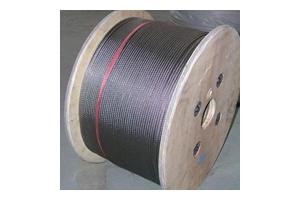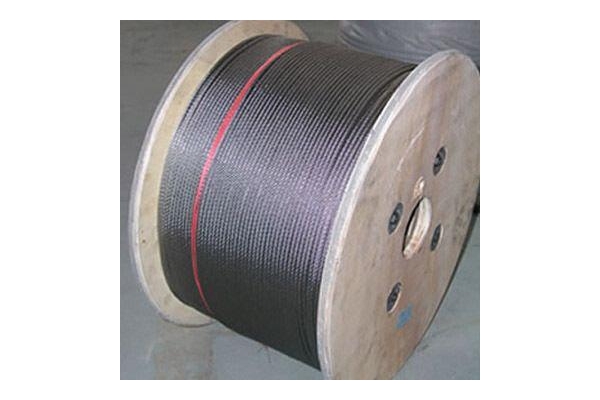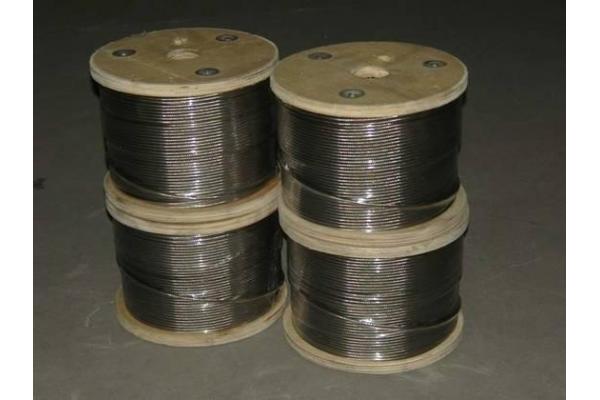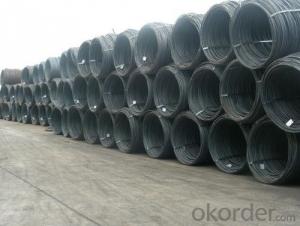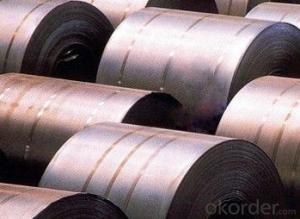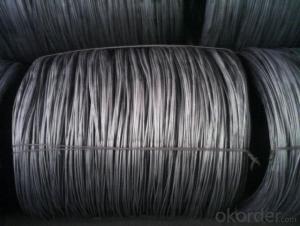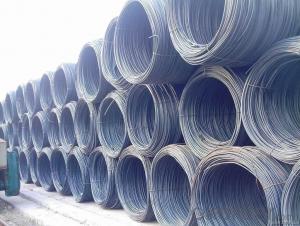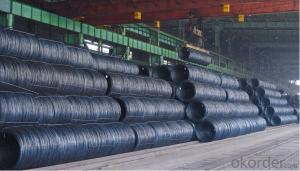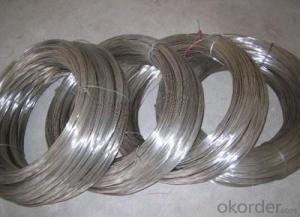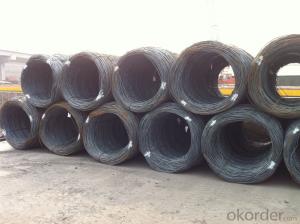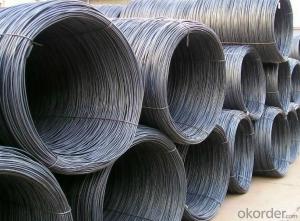Steel Wire
- Loading Port:
- China Main Port
- Payment Terms:
- TT OR LC
- Min Order Qty:
- -
- Supply Capability:
- -
OKorder Service Pledge
OKorder Financial Service
You Might Also Like
Specifications
Electro Zinc plated wire have following:Varies specification,
Stable Zinc coating and kinds packages,
Wide application
Our Electro Zinc plated wire have following advantages:
1.Specifications
The common wire diam is from BWG 6 TO BWG 38(0.18mm to 5mm).The thinner or thicker ones are also available for customers' requirements.
2.Zinc coating:5-20 g/m2 T/S:300-600N/mm2
3.Packing
Z2 spool,DIN 200 plastic reel,coils(1.5kgs/coil-1000kgs/coil),plastic or weaving bag and so on,bulk or pallet are both OK.
4.Wide applications
Mainly used in construction,fenceing mesh of Express way,making brushes,binding wire,package products etc.
Diam | BWG 6 TO BWG 36(0.2MM to 5mm),or as customers' requirement |
Zinc coating | 30-280g/m2 |
Tensile Strength | 300-600N/mm2
|
Package | Z2 spool,DIN 200 plastic reel,coils(1.5kgs/coil-1000kgs/coil),plastic or weaving bag and so on |
- Q: What are the different types of steel wire rod finishes for improved lubricity?
- There are several types of steel wire rod finishes that can be used to enhance lubricity. These include zinc coating, phosphate coating, galvanizing, and polymer coatings. Zinc coating provides a protective layer and reduces friction, while phosphate coating improves surface adhesion for lubricants. Galvanizing involves applying a layer of zinc to the surface, which increases lubricity. Polymer coatings create a smooth and low-friction surface, further enhancing the lubricity of the steel wire rod.
- Q: How is steel wire rod used in the manufacturing of wire forms for automotive suspension systems?
- Steel wire rod is an essential component in the manufacturing of wire forms for automotive suspension systems. The wire rod is typically made from high-grade steel and undergoes a series of processes to ensure its strength and durability. Firstly, the steel wire rod is heated and then passed through a series of rollers to reduce its diameter to the desired size. This process is known as wire drawing and helps to improve the wire's surface finish and mechanical properties. Once the wire rod is drawn to the required diameter, it is further processed to enhance its strength and flexibility. This is achieved through a process called heat treatment, where the wire is heated to a specific temperature and then rapidly cooled. This treatment helps to align the steel's crystalline structure, resulting in increased tensile strength and improved ductility. The wire forms used in automotive suspension systems are typically made by bending and shaping the steel wire rod. These wire forms play a crucial role in providing stability and support to the suspension system, allowing it to absorb shocks and vibrations while maintaining the vehicle's balance and ride comfort. The wire forms are used in various suspension components, such as coil springs, torsion bars, stabilizer bars, and control arms. For example, coil springs are made by winding the steel wire rod into a helical shape, which provides the necessary elasticity to absorb and distribute the forces acting on the suspension system. Similarly, torsion bars are made by twisting the steel wire rod, creating a resilient bar that can resist twisting forces. Stabilizer bars, also known as anti-roll bars, are made by bending the wire rod into a U or S shape and then attaching it to the vehicle's suspension system. These bars help to reduce body roll during cornering, improving the vehicle's stability and handling. Furthermore, control arms, which connect the suspension system to the vehicle's chassis, are often made using steel wire rod. These components must be strong and rigid to support the weight of the vehicle and withstand the various forces encountered during driving. In summary, steel wire rod is a crucial material in the manufacturing of wire forms for automotive suspension systems. Its strength, durability, and versatility make it ideal for producing various suspension components that play a vital role in ensuring a smooth and controlled ride for vehicles.
- Q: What are the different tensile testing methods for steel wire rod?
- There are several different tensile testing methods that can be used to evaluate the mechanical properties of steel wire rods. These methods are designed to measure the strength, ductility, and other important characteristics of the material. Some of the most commonly used tensile testing methods for steel wire rods include: 1. Standard Tensile Test: This is the most basic method of tensile testing, where a sample of the steel wire rod is subjected to an increasing tensile load until it fractures. The load and elongation are continuously measured, allowing for the calculation of properties such as ultimate tensile strength, yield strength, and elongation at fracture. 2. Charpy Impact Test: This method evaluates the impact toughness of the steel wire rod by measuring the energy absorbed during the fracture of a notched specimen. It involves striking the sample with a pendulum hammer and recording the energy absorbed as the hammer breaks the specimen. This test is particularly useful for determining the resistance of the material to sudden impact or shock loading. 3. Bend Test: In this method, a steel wire rod specimen is bent to a specific angle without fracturing. The bend test is used to assess the ductility and resistance to cracking of the material. The sample is typically bent around a mandrel of a specified diameter, and any signs of cracking or fracture are noted. 4. Hardness Test: Hardness testing is a non-destructive method used to determine the resistance of the steel wire rod to penetration or indentation. Various hardness testing methods are available, including Rockwell, Brinell, and Vickers tests. These tests involve applying a known load to the specimen surface and measuring the depth or size of the resulting indentation. Hardness values can be correlated to tensile strength, making it a useful technique for quality control purposes. 5. Fatigue Test: Fatigue testing is used to evaluate the endurance limit and fatigue life of the steel wire rod under repeated cyclic loading. The specimen is subjected to a varying load or stress amplitude over a specified number of cycles until failure occurs. This test helps determine the material's ability to withstand repetitive loading conditions over time. Overall, these different tensile testing methods provide valuable insights into the mechanical properties of steel wire rods, helping engineers and manufacturers ensure the material meets the required specifications for their intended applications.
- Q: What are the different types of steel wire rod surface defects and their detection methods?
- There are various types of steel wire rod surface defects that can occur during the manufacturing process. These defects can significantly affect the quality and integrity of the wire rod, making it essential to detect and address them before they cause any further issues. Here are some common types of steel wire rod surface defects and their detection methods: 1. Scale: Scale refers to the presence of oxide layers on the surface of the wire rod. It can occur due to exposure to high temperatures during production. Scale can be detected visually by examining the wire rod's surface for discoloration or by performing a simple scratch test to check if the scale flakes off easily. 2. Cracks: Cracks in the surface of the wire rod can be caused by various factors such as improper cooling, excessive stress, or material defects. Visual inspection is the most common detection method, where the wire rod is examined for visible cracks or fracture lines. Additionally, non-destructive testing techniques like magnetic particle inspection or ultrasonic testing can be employed for more accurate and reliable crack detection. 3. Pitting: Pitting is the formation of small depressions or cavities on the wire rod's surface due to corrosion or mechanical damage. Visual inspection is usually sufficient to detect pitting, as it appears as small, localized areas with irregular surfaces or indentations. However, if pitting is not easily visible, techniques like dye penetrant inspection or eddy current testing can be used for a more detailed examination. 4. Surface roughness: Surface roughness refers to an uneven or irregular texture on the wire rod's surface. It can occur due to improper manufacturing processes or inadequate quality control. Visual inspection can detect surface roughness by examining the wire rod for inconsistencies in the smoothness or by using a profilometer to measure the roughness quantitatively. 5. Inclusions: Inclusions are non-metallic substances (e.g., slag, dirt, or oxide particles) embedded in the wire rod's surface. They can cause weak spots or affect the wire rod's mechanical properties. Visual inspection can detect large inclusions, while microscopic examination or techniques like X-ray inspection can identify smaller or subsurface inclusions. 6. Coating defects: If the wire rod has a coating, defects like peeling, blistering, or uneven thickness can occur. Visual inspection is generally sufficient to detect these defects, but additional techniques like ultrasonic testing or electrical conductivity measurements can be employed for a more comprehensive assessment. It is important to note that while visual inspection is commonly used, more advanced techniques like non-destructive testing (NDT) methods can provide more accurate and reliable detection of surface defects. Employing a combination of these methods can ensure the identification and rectification of any surface defects in steel wire rods, ultimately enhancing their quality and performance.
- Q: How is steel wire rod used in the production of tire cords?
- Steel wire rod is an essential component in the production of tire cords. Tire cords are reinforcements that are embedded within the rubber of tires to provide strength and support. Steel wire rod is first processed through a series of steps to transform it into the desired form for tire cord production. The steel wire rod is initially hot rolled to reduce its diameter and increase its length. This process adds strength and flexibility to the wire rod, making it suitable for tire cord applications. After hot rolling, the wire rod is further processed through a heat treatment known as patenting. This heat treatment enhances the wire's mechanical properties, such as tensile strength and elasticity, ensuring it can withstand the demanding conditions experienced by tires. Once the steel wire rod has been appropriately processed, it is then drawn through a series of dies to achieve the desired diameter and surface finish. This drawing process further enhances the wire's strength and surface quality, ensuring it meets the stringent requirements for tire cord production. The drawn steel wire rod is then coated with a layer of brass or zinc to improve its adhesion to the rubber compound used in tire manufacturing. This coating also provides corrosion resistance, extending the lifespan of the tire cords. Finally, the coated steel wire rod is twisted into cord structures with multiple strands, forming the tire cord. These cords are then embedded into the rubber during the tire manufacturing process. The tire cords provide essential reinforcement, helping the tire withstand the internal pressure, external forces, and provide stability during vehicle movement. In summary, steel wire rod is a crucial material used in the production of tire cords. Through a series of processing steps, including hot rolling, heat treatment, drawing, and coating, the wire rod is transformed into high-strength and durable cords. These cords are then embedded within the rubber of tires to provide essential reinforcement and support, ensuring the tires can withstand the challenging conditions they encounter on the road.
- Q: How are steel wire rods used in the manufacturing of wire brushes for cleaning purposes?
- Steel wire rods are an essential component in the manufacturing of wire brushes for cleaning purposes. These wire rods are typically made from high-quality steel, known for its strength, durability, and flexibility. To create wire brushes, the steel wire rods undergo a series of processes. First, the wire rods are carefully selected based on their composition and tensile strength. They are then passed through a wire drawing machine, which reduces their diameter and increases their length. This process allows for the creation of thin and long wires that are perfect for brush bristles. Once the wires are drawn, they are straightened and cut to the desired length. The lengths can vary depending on the type of brush being produced. The straightened wires are then inserted into a metal ferrule or twisted together to form a bundle, depending on the brush design. The wire bristles are then attached to a handle or base, which can be made of wood, plastic, or metal. This assembly process can be done manually or with the help of specialized machinery. The bristles are secured tightly to ensure they do not come loose during use. Steel wire rods are favored for manufacturing wire brushes due to their excellent cleaning properties. The strength and flexibility of steel allow the bristles to effectively remove dirt, grime, and debris from various surfaces. They can be used on a wide range of materials, including metal, wood, and concrete. Wire brushes made from steel wire rods are commonly used for cleaning applications such as removing rust, paint, or corrosion from surfaces, preparing surfaces for painting or welding, cleaning welding joints, and scrubbing hard-to-reach areas. They are also utilized in industries such as automotive, manufacturing, construction, and maintenance. In summary, steel wire rods play a crucial role in the manufacturing of wire brushes for cleaning purposes. Their strength, durability, and flexibility make them ideal for creating effective and reliable cleaning tools. Whether it's for removing rust, cleaning welds, or scrubbing surfaces, wire brushes made from steel wire rods are an essential tool in many industries and households.
- Q: What are the factors that affect the tensile strength of steel wire rod?
- The tensile strength of steel wire rod can be affected by various factors. These factors include: 1. The chemical composition of the steel, such as carbon, manganese, and silicon. The specific combination of elements can have a significant impact on the tensile strength. Higher carbon content generally increases strength, while other alloying elements can enhance or reduce strength based on their properties. 2. The heat treatment process, which involves heating and cooling the steel wire rod. This process can alter the microstructure of the steel and ultimately affect its tensile strength. Different methods, like quenching and tempering, can be used to achieve the desired strength level. 3. The manufacturing process of the steel wire rod. The way the rod is produced and processed can influence its tensile strength. Factors like rolling temperature, reduction ratio, and cooling rate can affect the alignment of the steel's crystalline structure, which in turn affects its strength properties. 4. The grain size of the steel wire rod. The size of the grains in the steel can impact its tensile strength. Smaller grain sizes generally result in higher strength, as they provide more barriers for dislocations to move through the material. 5. The surface condition of the steel wire rod. The presence of surface defects, such as cracks or scratches, can weaken the tensile strength. Therefore, proper surface treatment and handling during manufacturing and transportation are crucial for maintaining its strength. 6. The environmental conditions in which the steel wire rod is used. Factors like temperature, humidity, and exposure to corrosive substances can degrade or embrittle the material, leading to reduced strength. In conclusion, the tensile strength of steel wire rod is influenced by its chemical composition, heat treatment, manufacturing process, grain size, surface condition, and environmental factors. It is important to understand and control these factors to ensure the desired strength and performance of the steel wire rod in different applications.
- Q: What are the major opportunities for companies in the steel wire rod market?
- Some major opportunities for companies in the steel wire rod market include expanding into emerging economies with growing construction and infrastructure sectors, diversifying product offerings to cater to various industries such as automotive and aerospace, embracing technological advancements to improve production efficiency and quality, and exploring sustainable practices to meet the growing demand for environmentally friendly steel products.
- Q: What are the common production processes for tin-coated steel wire rod?
- The common production processes for tin-coated steel wire rod include wire drawing, cleaning and coating. Wire drawing involves pulling the steel wire through a series of dies to reduce its diameter and improve its surface finish. Cleaning is done to remove any impurities or contaminants from the wire surface. Finally, the wire rod is coated with a layer of tin using methods such as hot-dipping or electroplating to provide it with corrosion resistance and other desired properties.
- Q: How are steel wire rods used in the production of wire ropes for ships?
- Steel wire rods are of utmost importance in manufacturing wire ropes for ships. These rods serve as the primary material for producing wire ropes. To begin with, steel wire rods undergo a series of processes to convert them into wire strands. This entails drawing the rods through multiple dies to decrease their diameter and increase their length. This process ultimately forms thin and elongated wire strands. Subsequently, these wire strands are twisted together to form a cable core. The number of strands used and the direction of the twist depend on the specific requirements of the wire rope. This cable core provides the foundation and strength for the wire rope. Once the cable core is established, it is typically enveloped with an outer layer known as the wire rope's outer strands. These outer strands are also produced using steel wire rods. They are twisted around the cable core in a specific pattern to ensure strength, flexibility, and durability. The utilization of steel wire rods in manufacturing wire ropes for ships is crucial due to the exceptional properties of the material. Steel is renowned for its high tensile strength, resistance to corrosion, and durability, making it an ideal choice for maritime applications. These characteristics enable wire ropes made from steel wire rods to withstand the extreme forces and harsh environments encountered at sea. In conclusion, steel wire rods play a vital role in the production of wire ropes for ships. These rods are transformed into wire strands, which are then twisted together to create the cable core. The cable core is further encased with outer strands, resulting in a robust and resilient wire rope capable of enduring the demanding conditions of maritime operations.
Send your message to us
Steel Wire
- Loading Port:
- China Main Port
- Payment Terms:
- TT OR LC
- Min Order Qty:
- -
- Supply Capability:
- -
OKorder Service Pledge
OKorder Financial Service
Similar products
Hot products
Hot Searches
Related keywords
